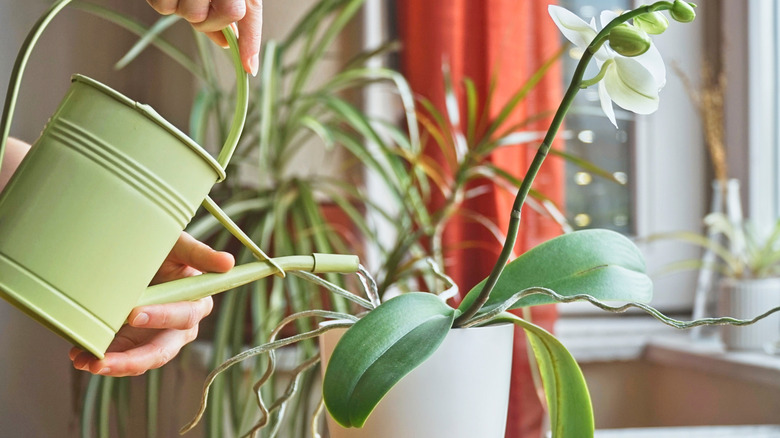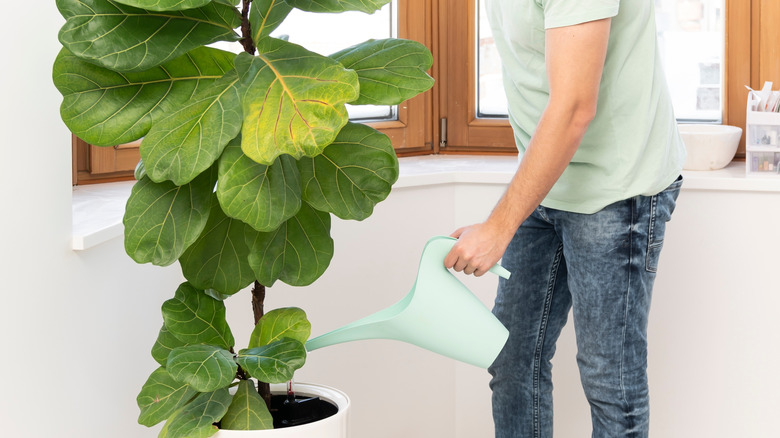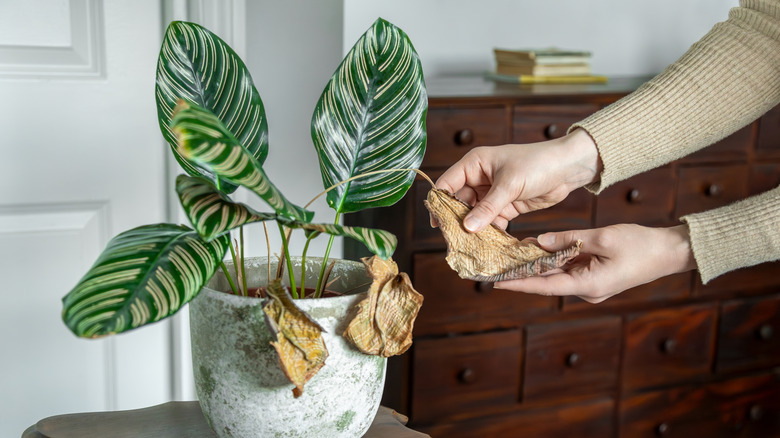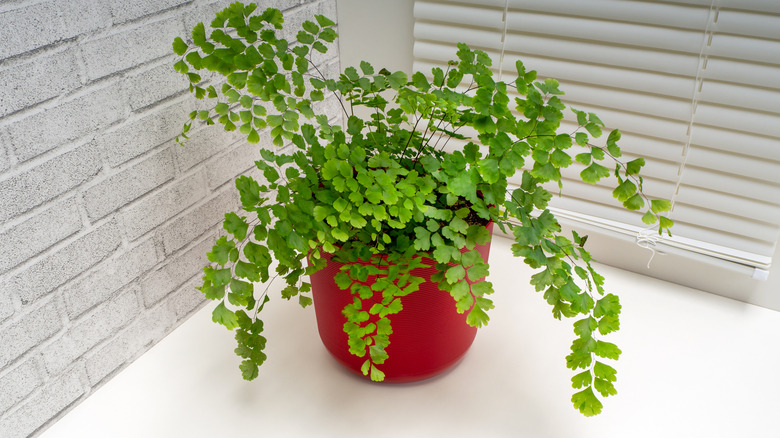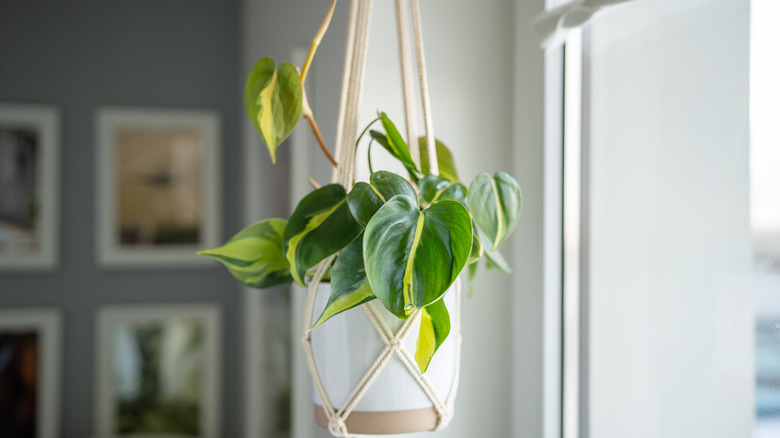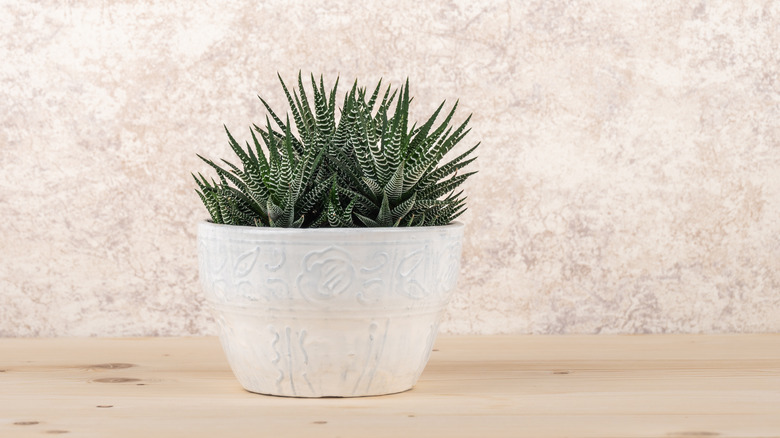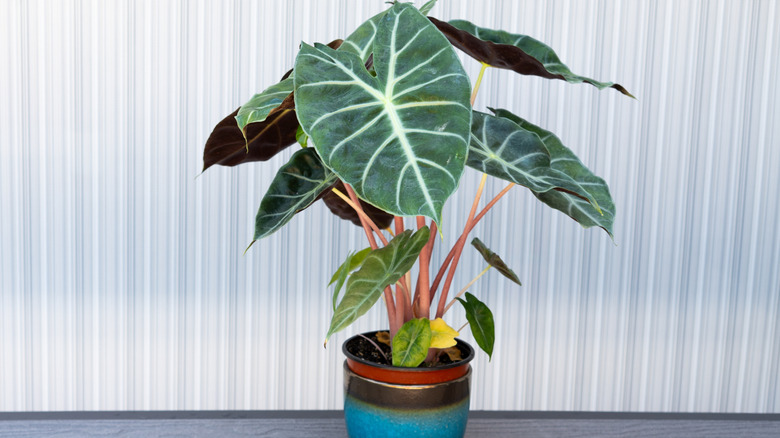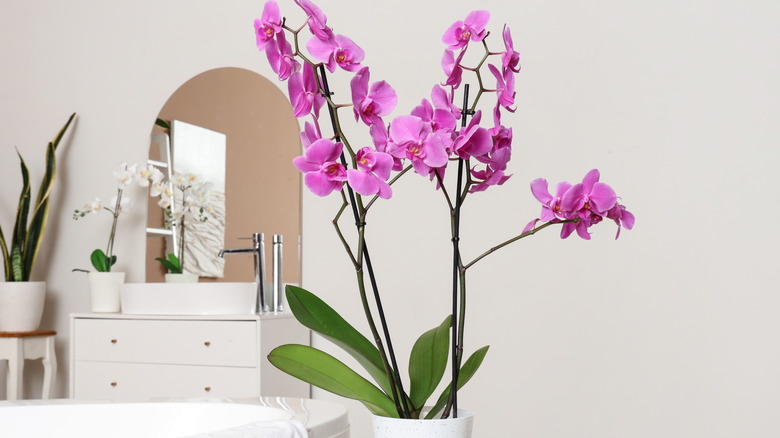High-Maintenance Houseplants Everyone Is Ditching In 2025 For Easier Alternatives
Many proud plant parents are finally coming to a realization: The Instagram-worthy green beauties they embraced as houseplants during pandemic years no longer work with their busy schedules. The three-times-a-day misting sessions, the round-the-clock humidity app reminders, and the constant head-scratching about browning leaves are more trouble than it's worth. Worse, they might be adding to your everyday stress, rather than busting it. But since indoor plants make a stylish statement and enhance our connection with nature, don't shun them altogether. Instead, trade your high-maintenance divas with easy-care beauties that flourish with minimal effort.
To find out which fussy houseplants everyone is ditching in 2025, House Digest exclusively interviewed six experts to gather their opinions. Their top picks include fiddle leaf figs, calatheas, maidenhair ferns, philodendron brasil, succulents, alocasia 'Polly,' and orchids. They also open up about the forgiving green babies taking their place. Interested in knowing more? Here are seven high-maintenance houseplants you should replace with easier alternatives in 2025.
The fiddle leaf fig is being phased out for rubber trees
Not too long ago, the fiddle leaf fig (Ficus lyrata) was a mainstay in home décor. You saw it in architecture magazines, luxurious photo shoots, and Instagram reels. This was mainly due to its deeply-veined, sculptural leaves arranged like a violin along a thin trunk. Not anymore, though, according to Tammy Sons, Founder and CEO of TN Nursery, which has been around for 60 years across three generations. In her exclusive interview with House Digest, she shares, "The 2025 trend at TN Nursery shows plant enthusiasts have started avoiding fiddle leaf figs. Their beautiful appearance comes with a high-maintenance reputation because they react negatively to light changes and drop leaves easily while needing precise watering." Since they're such divas that might as well call them fickle leaf. Sons feels caring for them can be overwhelming for busy homeowners.
In place of the fiddle leaf fig, Sons advises growing a rubber tree (Ficus elastica). Apart from making a dramatic statement with their bold foliage, she feels they've "fantastic adaptability" and are easy to care for. "This plant displays identical bold and glossy leaves while requiring less maintenance from homeowners. Rubber trees show greater resilience to different lighting environments and need less precise watering while rewarding occasional neglect with sustained healthy growth." Although not a fan of cold drafts, rubber trees can tolerate dry indoor air much better than most humidity-loving houseplants, so it's especially great for those living in drier climates.
Calatheas are being swapped out for peperomias
Calatheas (Calathea spp.) may have become indoor darlings due to their bold, lush foliage that immediately perks up the room. But they exact a heavy price for it: high maintenance that only the most patient plant parents can hope to fulfill. Imagine having to maintain a rain barrel because your precious plant is sensitive to the fluoride present in tap water. Or, setting aside a dedicated space because this humidity lover can't imagine staying in a room whose moisture levels don't exceed 70%. As homeowners have had enough of her tantrums, they're looking to replace it, claims Michael Clarke, landscape architect and founder of Yardwork. Elaborating on this in his interview with House Digest, he says, "Calathea is another high-maintenance plant that needs high humidity, purified water, and precise light to avoid crispy, curled leaves. Without a humidifier running 24/7, calatheas will constantly look unhappy."
So, which houseplant is taking over the place of calatheas? Clarke recommends peperomia (Peperomia spp.). This is because it "offers similar leaf textures and patterns, but tolerates average humidity and water from the tap." Plus, it easily adapts to the typical conditions available inside your home, which includes lower humidity. So, you won't need a green thumb to care for this gorgeous houseplant. You can even pop it in a low-light area or atop the radiator (fun fact: it's also called radiator plant because it loves the warmth). However, keep it away from cold winds.
Maidenhair ferns are being replaced by bird's nest ferns
Another houseplant Clarke believes homeowners will ditch in 2025 due to its intensive care requirements is the maidenhair fern (Adiantum spp.). Since most of these ferns originate from tropical forests, they demand protection from direct sunlight and a high-nutrient diet that can be difficult to meet inside. "The Maidenhair Fern also needs constant moisture, dislikes being touched, and wilts instantly when dry, being too fragile for most homeowners," he expands. Indeed, maidenhair ferns cannot survive for long in dry conditions and must be placed in glass terrariums or cloches to successfully meet their high humidity demands.
To avoid all this fuss and still deck your home with a black-stemmed fern, Clarke advises switching to bird's nest fern (Asplenium nidus). It "has a similar fern look but is sturdier and more forgiving," he explains. Since the fronds sprawl out and form a rosette in the center, they can catch decaying or dead leaves, which ultimately decompose to nourish the plant. This reduces their fertilization requirements, though a monthly feed of slow-release fertilizer will work wonders during the active growth season. Remember that you may have to mist the plants or place them over a water-holding, pebble tray if your home remains very dry.
Philodendron 'Brasil' is being switched out for golden pothos
Before you gasp in horror, we get it. Philodendron 'Brasil' (Philodendron hederaceum 'Brasil') is pretty to look at and is easy to care for — generally. But do you know what's even easier to maintain? Golden pothos (Epipremnum aureum), which is why Lindsay Springer, Ph.D., director of plants, nutrition, and digital agriculture at Gardyn, opines that homeowners will lean toward these vining plants to give their indoor space a fresh look in 2025. In her exclusive interview with House Digest, she explains, "Golden Pothos are wonderfully tolerant, draping, and less dramatic than other trailing plants like philodendron 'Brasil.'"
Although both houseplants look similar, displaying unique variegation across their heart-shaped leaves, there are some big differences between pothos and philodendrons. Golden pothos has a slightly leathery and sturdier texture. Plus, it can better tolerate poor light conditions. It also has decent drought tolerance, making a superior choice for people who might forget to water or mist their plants. In contrast, philodendrons require moist soils and high humidity. Moreover, pothos isn't as fertilizer-hungry, often surviving at half the strength, whereas philodendrons are heavy on nitrogen demands. Overall, if you're looking for indoor plants that thrive on neglect, but don't look the part, consider bringing golden pothos home.
Succulents are being traded for hoyas
Succulents are no longer the sought-after, easy-care, collectible houseplant anymore, feels Stephen Kohley, owner of Sonny Alexander Florist & Flower Delivery. Interviewing with House Digest, he explains, "Even though they are usually sold as low-maintenance, I've found that succulents (like echeveria and haworthia as an example) actually need a lot of direct sunlight, which isn't always easy to come by indoors." As a result, they grow spindly, flatten or fade out, and might even die from inadequate light exposure.
He also feels that succulents are often plagued by overwatering, which results in root rot, "especially in pots that don't drain well, which is a common setup indoors." He thinks some succulents are unfit for indoors, while others begin looking boring over time — a situation worsened by slow growth rates. The final nail in the coffin is that succulents don't really suit the trendy biophilic design. "They are also very small, so they don't provide the lush, lovely tones of other plants that are leafier, more colorful, and easier to style in a home."
Instead of succulents, Kohley advises growing hoyas (which are actually considered semi-succulents), because they make the "best low-effort plant." Explaining his reasons, he says, "These wax plants have glossy, thick leaves that are much nicer to look at, and can fill a space much better than a succulent." They're also better suited to indoor humidity levels, as well as darkly lit areas, and are less likely to rot. Though rare, star-shaped blooms are another plus.
Alocasia 'Polly' is being ditched for monstera
Speaking exclusively to House Digest, Trela Phelps, who has over 35 years of hands-on experience at City Floral, a historic Denver garden center established in 1911, feels alocasia 'Polly' (Alocasia × amazonica 'Polly') is losing favor with homeowners. Even though this beauty still looks stylish as ever with white veins running dramatically across its dark green leaves, it's too high-maintenance. Owing to their tropical origins, these houseplants, "require high humidity during the spring and summer and are easily overwatered," she elaborates. Overwatering is especially an issue during winter when growth slows and minimizes water needs. "During the winter, they take a resting period, which becomes problematic for the houseplant owner, requiring even less water; they can lose their leaves and look very unattractive," she adds.
With homeowners looking for easy care options, she deems monstera or split-leaf philodendron (Monstera deliciosa) a suitable alternative to alocasia 'Polly.' The National Garden Bureau announcing 2025 as the Year of the Monstera and the plant regularly featured "on novelty items such as clothing, stickers, and coffee mugs" further alludes to it becoming popular with homeowners. Plus, she mentions, "Monstera is easy to grow, requiring only bright light and moderate watering. It is a fast-growing plant, and any results of mishandling in care can be removed or cut back, and in no time, the new growth covers any imperfections." As a bonus, the splits in the heart-shaped foliage filter in the light, "creating a relaxing, vacation-type feeling."
Orchids are being replaced by peace lilies
Another plant that seems to have fallen on the wayside is the orchid, feels Jennifer Cassels, a gardening expert and president of The Blissful Place, a leading online retailer of luxury outdoor decor. Explaining the reasons for this in her exclusive interview with House Digest, she says, "Orchids are incredibly stunning when in full bloom, yet they are infamous for needing meticulous care, such as specific temperature ranges, high air circulation, and delicate watering techniques to rebloom." Besides being classified into three distinct groups with their own temperature ranges, orchids have specific day-and-night and seasonal fluctuation requirements that must be fulfilled to ensure flowering. Moreover, you'll have to constantly worry about striking the right balance between air circulation and humidity. And if that isn't overwhelming, orchids are also quite fussy about their watering needs, which are a huge contrast to other houseplants.
Since successfully caring for indoor orchids can be difficult, Cassels recommends peace lilies (Spathiphyllum spp.) instead. "While the blooms of peace lilies may differ in shape and structure from orchid flowers, their elegant white flowers offer a similar sense of refinement." Plus, they help purify the indoor air, according to NASA's Clean Air Study. Another plus is that "peace lilies are comparatively easier to maintain, as they flourish in low light and can recover from neglect while still providing understated charm to any space." However, when accidentally chewed, peace lilies can be toxic for your children and furry friends, so keep them away from reach.
